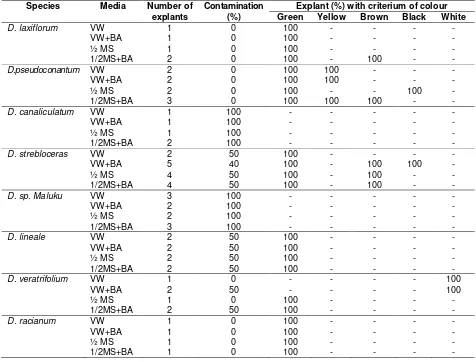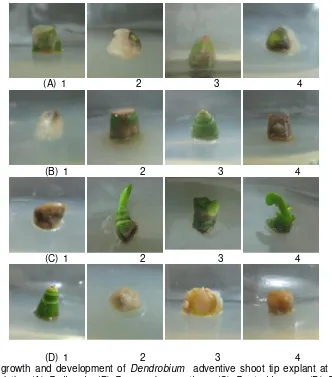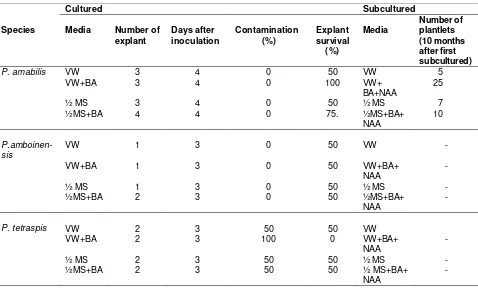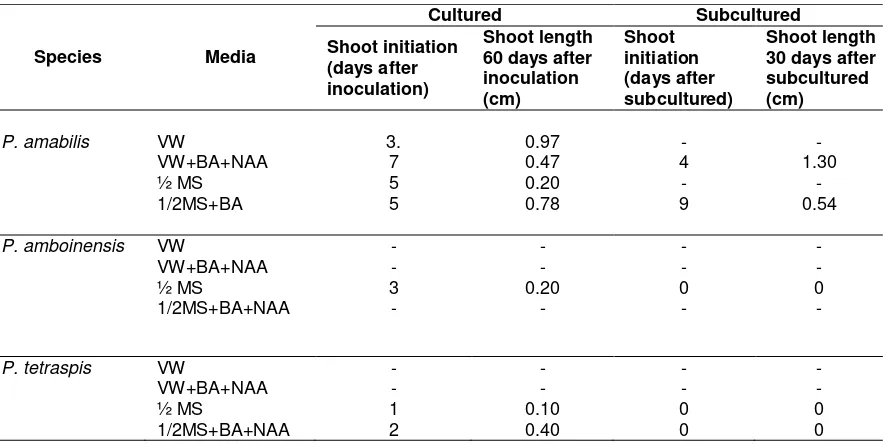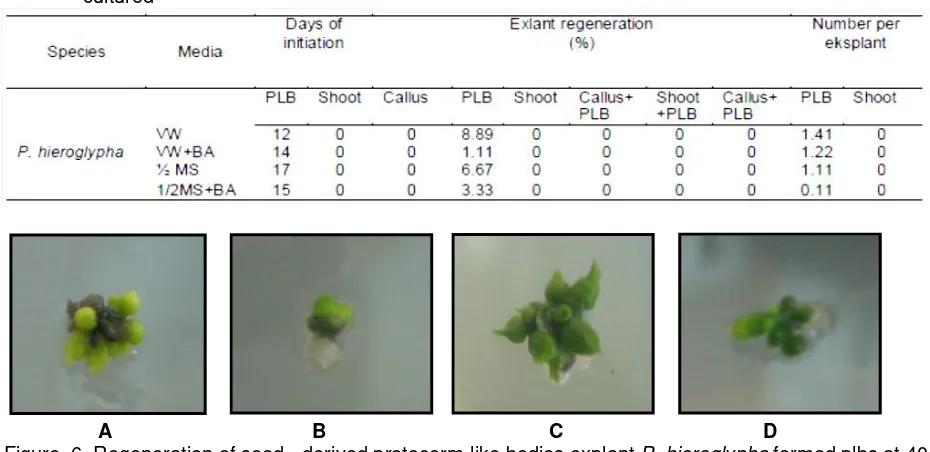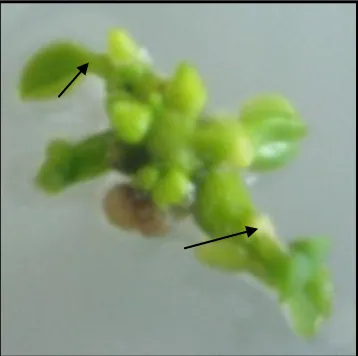AGRIVITA VOLUME 34 No. 2 JUNE-2012 ISSN : 0126-0537
IN VITRO PROPAGATION OF
DENDROBIUM
AND
PHALAENOPSIS
THROUGH TISSUE CULTURE FOR CONSERVATION
Lita Soetopo*) and Sri Lestari Purnamaningsih Faculty of Agriculture University of Brawijaya Jl Veteran Malang 65145 East Java Indonesia
*) Corresponding author Phone +62-341-551665 E-mail: ltsfpub@yahoo.co.id
Received: April 4, 2012/ Accepted: June 5, 2012
ABSTRACT
The studies were focused on developing an efficient and effective propagation protocol for orchid species from genera Dendrobioum and Phalaenopsis through tissue culture. The Materials used were explants from adventive shoot tip, floral stalk buds and PLBs derived veratrifolium. However, plantlets regeneration occurred only on D. pseudoconantum, and D. strebloceras. Explant regeneration from seed derived protocorm-like bodies on D. spectabile occurred 40 days after inoculation transfer and subculture. High survival percentage of explant from floral stalk shoot was shown by P. amabilis. There were several plantlets surviving in acclimatisation. Explant regeneration from seed derived from protocorm-like bodies on P. hieroglypha occurred 40 days after inoculation and subculture. It was suggested that for ex situ conservation on certain species of Dendrobium and Phalaenopsis in the category of rare germplasms, tissue culture could be applied effectively and efficiently by using explant from adventive shoot tip, floral stalk buds and seed derived protocorm-like body explant for vegetative seed multiplication. For example, orchids, such as Dendrobium and
Phalaenopsis, which contain some species that are close to extinction, urgently require conservation. Indonesia with its climate and tropical rainforest is an ideal habitat for many orchid species. At present the existence of orchid germplasms in their natural habitat is at risk because of illegal selling, logging, and natural disaster. Their population is also drastically declining because of a lower rate of propagation in nature and overexploitation. One of the means for ex situ conservation is by propagation through in vitro culture.
Cloning technique by tissue culture resulted in vegetative propagation in mass number and the offspring genetically similar to the parental plant. It has made a possible choice for ex situ conservation in orchid. Many types of explants such as shoot tips (Sagawa and bodies derived from mature seeds (Shimura and Koda, 2004) have been used as explants in tissue culture to produce plantlets.
Some Dendrobium and Phalaenopsis species were chosen to be employed in this study in order to investigate suitable explants material that is good for in vitro propagation. By using this method, valuable plants can be conserved and exploited.
MATERIALS AND METHODS
Phalaenopsis. Dendrobium species used were from different sections: section Spatulata (Ceratobium) i.e. Dendrobium stratiotes and D. lasianthera; section Eleuteroglossum i.e D. canaliculatum; section Latourea i.e. D. spectabile . Furthermore, some species from genus Phalaenopsis i.e. Phalaenopsis amabilis, P.. amboinensis, P. hieroglypha and P. tetraspis were used. bottle containing 30 ml solid medium. The media were VW, VW+0.5 mg l-1BA, ½ MS and ½ MS+0.5 mg l-1BA. Two months after cultured, explants were cut into pieces and subcultured into fresh medium containing similar medium with the addition of 2 mg l-1 BA and 0.5 mg l -1
NAA. It was a descriptive experiment and because of insufficient number of explants, there was no replication used.
Another type of explant used in this experiment was four-month old PLBs derived from seeds. These seed-derived protocorm-like bodies (plbs) were longitudinally bisected. Ten explants were placed on medium as previously described. Regenerated plbs were subcultured into fresh medium containing similar medium with the addition of NAA. Cultures were maintained at temperature 25o ± 2o C, light intenstity of 30-40 µ mol m-2 s-1 and photoperiods of 16 hours in light and 8 hours in dark.
Observation was made, percentage of explant contamination, colour of explants, days of callus or plb initiation, percentage and number of explant development, and number of regenerated plantletswere recorded.
RESULTS AND DISCUSSION
In Vitro Propagation of Dendrobium and Phalaenopsis………..
Table 1. The growth and development of adventive shoot tip explants of Dendrobium species on in vitro culture
Species Media Number of
explants
Contamination (%)
Explant (%) with criterium of colour
Green Yellow Brown Black White
D. laxiflorum VW 1 0 100 - - - -
VW+BA 1 0 100 - - - -
½ MS 1 0 100 - - - -
1/2MS+BA 2 0 100 - 100 - -
D.pseudoconantum VW 2 0 100 100 - - -
VW+BA 2 0 100 100 - - -
½ MS 2 0 100 - - 100 -
1/2MS+BA 3 0 100 100 100 - - D. canaliculatum VW 1 100 - - - - -
VW+BA 1 100 - - - - -
½ MS 1 100 - - - - -
1/2MS+BA 2 100 - - - - -
D. strebloceras VW 2 50 100 - - - -
VW+BA 5 40 100 - 100 100 -
½ MS 4 50 100 - 100 - -
1/2MS+BA 4 50 100 - 100 - - D. sp. Maluku VW 3 100 - - - - -
VW+BA 2 100 - - - - -
½ MS 2 100 - - - - -
1/2MS+BA 3 100 - - - - -
D. lineale VW 2 50 100 - - - -
VW+BA 2 50 100 - - - -
½ MS 2 50 100 - - - -
1/2MS+BA 2 50 100 - - - -
D. veratrifolium VW 1 0 - - - - 100
VW+BA 2 50 - - - - 100
½ MS 1 0 100 - - - -
1/2MS+BA 2 50 100 - - - -
D. racianum VW 1 0 100 - - - -
VW+BA 1 0 100 - - - -
½ MS 1 0 100 - - - -
1/2MS+BA 1 0 100 - - - -
The results of experiment, from which part of the method showed that number of plantlets of D. pseudoconantum regenerated on VW and VW+BA+NAA that survived in acclimatisation was 75 and 2, respectively. All plantlets regenerated on ½ MS and on ½ MS+BA+NAA died. While on D. strebloceras was 11 on VW, 26 on VW+BA+NAA, 11 on ½ MS, and 11 on ½ MS+BA+NAA (Table 2). The number of explant regeneration from seed derived protocorm-like bodies on D. spectabile was 22 calli and 10 plb on VW; 44 shoot on VW+BA; 44 plb and 44 shoot on ½ MS; 10 calli and 11 shoot on ½ MS+BA (Table 3.).
(A) 1 2 3 4
(B) 1 2 3 4
(C) 1 2 3 4
(D) 1 2 3 4
Figure 1. The growth and development of Dendrobium adventive shoot tip explant at 40 days after inoculation (A) D. lineale, (B) D. pseudoconanthum, (C) D. strebloceras, (D) D. veratrifolium, on media (1)VW, (2) VW + BA, (3) ½ MS, (4) ½ MS + BA
A1 A2
In Vitro Propagation of Dendrobium and Phalaenopsis………..
Table 3 Explant regeneration of seed derived protocorm-like bodies explants of Dendrobium species on in vitro culture 40 days after inoculation
Species Media Number of
explant
Contamination (%)
Number of explant regeneration
Number per explant
Callus PLB Shoot PLB Shoot
D. spectabile VW 100 0 2.2 10 0 26 0
VW+BA 100 10 0 0 44 0 4
½ MS 100 10 0 44 44 7 7
1/2MS+BA 100 10 10 0 11 0 1
D. lasianthera VW 50 100 0 0 0 - -
VW+BA 50 100 0 0 0 - -
½ MS 50 40 0 0 0 - -
1/2MS+BA 50 20 0 0 0 - -
D. ascipilanense VW 130 76.92 0 0 0 - -
VW+BA 80 50.00 0 0 0 - -
½ MS 90 55.56 0 0 0 - -
1/2MS+BA 50 0 0 0 0 - -
Although the existence of plant growth hormone was essential for callus induction, callus differentiation took place on ½ MS medium without addition of plant growth hormone. Plb regeneration process from callus and its germination did not depend on exogenous plant growth hormone (Ishii et al., 1998; Roy and Banarjee, 2003; Zhao, et.al,, 2008). It differed from embryonic callus of many species which needed the addition of specific plant growth hormone for somatic embryo-genesis (Huan et al., 2004; Luo et al., 1999; Chengalrayan et al., 2001). In callus induction, syntesis system of endogenous hormone could be triggered and the rate of hormone raised allowing the cells to proliferate and differentiate on medium without exogenous plant growth hormone (Smith and Krikorian, 1990).
Dendrobium Seed-Derived Protocorm Like Bodies Explant
Table 3 shows that contamination was on plb explant D. ascipilense (0-76.92%)and D. lasianthera (20-100%).
Meanwhile, on D.spectabile, the conta-mination was 0-10%. Explant regeneration of seed - derived plb of D. spectabile 40 days after cultured had formed callus, plb, and shoot (Figure. 3)
Figure 3. Regeneration of D. spectabile seed - derived protocorm-like bodies explant after subcultured on media (a) VW (b) VW+BA (c) ½ MS (d) ½ MS+BA
Table 4. Explant regeneration of seed derived protocorm-like bodies explants of Dendrobium species on in vitro culture 40 days after subcultured
Species Media
Explant regeneration after subcultured Days of
initiation
Percentage of development (%)
Number per explant
PLB Shoot Callus PLB Shoot Callus +PLB
Shoot+ PLB
PLB Shoot
D. spectabile VW 14 9 44.40 33.30 33.30 22.20 33.30 26 38 VW+BA+NAA 14 10 0.00 0.00 33.30 0.00 11.10 3 7
½ MS 13 9 22.20 55.60 11.10 0.00 44.40 40 11
½MS+BA+NAA 12 3 11.10 44.44 33.30 7.78 22.20 47 47
In many plant species, callus plays an important part in the in vitro plant regeneration. In several orchid species, callus has also been induced successfully. Although at first orchid tissue culture did not focus on callus induction because the rate of growth was low and necrotic in the culture ((Zhao et.al, 2008). But recently, many lines having been produced on several orchid species were from callus (Lee and Lee, 2003; Lu, 2004). Actually, in order to obtain the same plant material, most of the time, callus was to be avoided since some characteristics might have changed. In this case, it will be better to obtain protocorm-like bodies.
usually through middle phase protocorm-like body.
On D. candidum, different development of granules globular callus came from inside or outside callus that formed cells with solid cytoplasm and little vacuoles (Zhao, et al., 2008). It was the characteristic of embryonic cells (Eady et al., 1998; Li et al., 2001; Nikam et al., 2003). Those granules could develop into plbs and the plbs in the suitable condition would develop into plantlets. While the other plbs could proliferate further and formed secondary plbs, this was a common characteristic of many orchid species (Wimber, 1963; Arditti and Ernst, 1993). Those calli succeded to grow into plantlet
via indirect protocorm like bodies for mass production. Callus induction from protocorm segment was enhanced by growth hormone like BA. It was reported that BA succeeded in inducing callus on D. fimbriatum (Roy and Banarjee, 2003), and D. candidum (Zhao et.al, 2008). Plant regeneration from callus culture on orchid is
Dendrobium spectabile needs warm condition in an open medium. Its growth is specific and it flowers only under specific environmental condition. The condition during
acclimatisation might not meet its requirement, which might explain the death of plantlets at acclimatitation.
Lita Soetopo and Sri Lestari Purnamaningsih: In Vitro Propagation of Dendrobium and Phalaenopsis………..
A B
C D
Figure 4. P. amabilis floral stalk bud explant regeneration at 60 days after inoculation on media (A) 1/2 MS (B) ½ MS+BA+NAA (C) VW (D) VW+BA+NAA
Table 5. Plant regeneration of Phalaenopsis explants from flower stalk buds on in vitro culture
Species
Cultured Subcultured
Media Number of
explant
Days after inoculation
Contamination (%)
Explant survival
(%)
Media
Number of plantlets (10 months after first subcultured)
P. amabilis VW 3 4 0 50 VW 5
VW+BA 3 4 0 100 VW+
BA+NAA
25
½ MS 3 4 0 50 ½ MS 7
½MS+BA 4 4 0 75. ½MS+BA+
NAA
10
P.amboinen-sis
VW 1 3 0 50 VW -
VW+BA 1 3 0 50 VW+BA+
NAA
-
½ MS 1 3 0 50 ½ MS -
½MS+BA 2 3 0 50 ½MS+BA+
NAA
-
P. tetraspis VW 2 3 50 50 VW
VW+BA 2 3 100 0 VW+BA+
NAA
-
½ MS 2 3 50 50 ½ MS -
½MS+BA 2 3 50 50 ½ MS+BA+
NAA
a
(A) (B)
Figure 5. P. amabilis plant from floral stalk bud explant after acclimatisation from media (a) VW (b) VW+BA+NAA
Table 6. Shoot initiation and length of Phalaenopsis explants from floral stalk buds on in vitro culture
Species Media
Cultured Subcultured
Shoot initiation (days after inoculation)
Shoot length 60 days after inoculation (cm)
Shoot initiation (days after subcultured)
Shoot length 30 days after subcultured (cm)
P. amabilis VW 3. 0.97 - -
VW+BA+NAA 7 0.47 4 1.30
½ MS 5 0.20 - -
1/2MS+BA 5 0.78 9 0.54
P. amboinensis VW - - - -
VW+BA+NAA - - - -
½ MS 3 0.20 0 0
1/2MS+BA+NAA - - - -
P. tetraspis VW - - - -
VW+BA+NAA - - - -
½ MS 1 0.10 0 0
1/2MS+BA+NAA 2 0.40 0 0
Remarks: - =explant death; 0= explant alive but no development
Data of acclimatisation shows that number of plantlets regenerating on VW, VW+BA+NAA, ½ MS, and ½ MS+BA+NAA which survived during acclimatisation was 5, 25 , 7, and 10, respectively (Figure. 5).
The mean of percentage of survival of explants of P. amboinensis and P. tetraspis was around 50%. Phalaenopsis tetraspis and P. amboinensis are Phalaenopsis species with a short stalk, while P. amabilisis had a long stalk.
Technically, there were different difficulties in preparing explant from those two types of
floral stalk buds. It was more difficult to prepare explant from a type of short flower stalk. Besides, it also grows slowly on in vitro culture and none grew any further.
Lita Soetopo and Sri Lestari Purnamaningsih: In Vitro Propagation of Dendrobium and Phalaenopsis………..
Phalaenopsis Seed - Derived Protocorm- like Bodies Explant
Table 7 shows that there was good growth and development of explant from seed - derived protocorm like-bodies 40 days after inoculation. The percentage of life explants of P. hieroglypha was 100% and explants regene-rating into plbs were 12.22 % on 1/2MS+BA and 7.78% on VW+BA.
It had been reported that callus could be formed from seed - derived protocorm with a frequency of 50% (Lu, 2004), from plbs segment 53% (Huan et.al, 2004), shoot tips 66.70% (Roy and Banarjee, 2003), and root tips 25% (Chen and Chang, 2000). After several subculturing,
the number of callus would replicate three to five times in a month and the average number of protocorm-like bodies was 90.7 per callus culture (Lu, 2004), 134 per 0.01 g fresh weight callus 134 per 0.01 g (Huan et al., 2004), 32.5 per mass callus (Roy and Banarjee, 2003), and 29.1 per 9 mm2 mass callus (Chen and Chang, 2000).
In this experiment, the percentage of the plb formation from explants of P. hieroglypha was 8.89% on VW, 1.11% on VW+BA, 6.67% on ½ MS and 3.33% on ½ MS+BA (Figure.6). After subculturing, the percentage of plbs formation was 5% plbs and 0.56% for the shoot formation (Figure. 7).
Table 7. Explant regeneration of Phalaenopsis seed - derived protocorm-like bodies 40 days after cultured
A B C D
Figure 6. Regeneration of seed - derived protocorm-like bodies explant P. hieroglypha formed plbs at 40 days after inoculation on media (A ½ MS (B) ½ MS+BA (C) VW (D) VW+BA
Table 8. Explant regeneration of Phalaenopsis explant protocorm-like bodies after first subcultured
Species
First subcultured Days of plb
initiation
Percentage of plb from explant (%)
Days of shoot initiation
Percentage of shoot from explant (%)
Number of plb per explant
Figure 7. P. hieroglypha seed-derived protocorm-like bodies explant formed shoots on medium ½ MS, 40 days after subculture
The percentage of plb formation was 8.89% on VW, 1.11% on VW+BA, 6.67% on ½ MS and 3.33% on ½ MS+BA. At the subcultured, the percentage of plb formation was 5% and the percentage of shoot formation was 0.56%.
Table 8 shows that after subcultured, explants of protocorm-like bodies of Phalae-nopsis formed plb. However, there was no plantlets of P.hieroglypha surviving during acclimatisation. The explant development was slow and the size was too small to be able to develop into normal plantlets.
In this experiment only plbs formed from seed-derived protocorm-like bodies of P. hiero-glypha and there was no plantlet surviving during acclimatitation. The regeneration process was slow and the plantlets size was small. It could be due to the genotypes or the consentration of growth hormone used in this experiment. However, further studies are required.
CONCLUSIONS AND SUGGESTIONS
CONCLUSIONS
There were two Dendrobium species that continued to regenerate from adventive shoot tip explant. The number of plantlets of D. pseudoconantum regenerating on VW, VW + BA that survived during acclimatisation was 75 and 2 respectively. No plantlets regenerating on ½ MS and ½ MS+BA of survived during acclimatisation. The number plantlets of D. strebloceras regenerating on VW was 11.26 on VW+BA, 11 on ½ MS, and 11 on ½ MS+BA. These planlets
survived during acclimatisation. Explant regeneration from seed - derived protocorm-like bodies was only performed by D. spectabile. The number of plbs per explant of D. spectabile after subcultured on VW; VW+BA; ½ MS; ½ MS+BA was 26, 3, 40, and 47. Shoot formation on VW, VW+BA, ½ MS and ½ MS + BA was 38, 7, 11, and 47 respectively.
Explant regeneration from floral stalk buds only P. amabilis. The percentage of survival plantlets of P. amabilis in acclimatisation was 62.5% on VW, 83.33% on VW+BA+NAA, 77.77% on ½ MS and 83.33% on ½ MS+BA+NAA. Survival percentage of explant from protocorm-like bodies on P. hieroglypha was 100%. The percentage of plb formation on VW; VW+BA, ½ MS, and ½ MS+BA was 8.89%,; 1.11%; 6.67% and 3.33%. Formation of plbs and shoot was 5% and 0.56% respectively. SUGGESTIONS
Lita Soetopo and Sri Lestari Purnamaningsih: In Vitro Propagation of Dendrobium and Phalaenopsis………..
ACKNOWLEDGEMENTS
This project was sponsored by the Indonesian Directorate General of Higher Education, Department of National Education, the Competitive Research According to National Priority Grant for International Publication Batch II, 2010.
REFERENCES
Arditti, J. and R. Ernst, . 1993. Micropropagation of Orchids. John Wiley and Sons. Inc. New York.
Chen, Jen-Tsung. and Wei-Chin Chang, 2000. Efficient plant regeneration through somatic embryogenesis from callus of Oncidium (Orchidaceae). Plant Sci. 160:87-93. Chen, Jen-Tsung and Wei-Chin Chang, 2004.
Induction of Repetitive Embryogenesis From Seed-Derived Protocorms of Phalaenopsis amabilis var. Formosa Shimadzu. In Vitro Cell. Dev.Biol-Plant 40:290-293.
Chengalrayan, K. S. Hazra and M. Gallo-Meagher. 2001. Histological analysis of somatic embryogenesis and organo-genesis induced from mature zygotic embryo-derived leaflets of peanut (Arachis hypogeae L.). Plant Sci. 161:415-421. Cymbidium orchid. Plant Sci. 166:1443-1449.
Dwiyati, M. and S. Anggorowati. 2011. Induction of In Vitro Culture of Potato Microtuber by Using Alar and Dark Photoperiod Application. J. Agrivita Vol 33 (1): 47-52. Eady, C.C., R.C. Butler and Y. Suo. 1998. Somatic
embryogenesis and plant regeneration from immature embryo cultures of onion (Allium cepa L.) Plant Cell Rep. 18:111-116.
Huan, L.V.T., T. Takamura and M. Tanaka. 2004. Callus formation and plant regeneration from callus through somatic embryo culture structures in Cymbidium orchid. Plant Sci. 166:1443-1449.
Ishii, Y, T. Takamura, M.Goi and M. Tanaka. 1998. Callus Induction and Somatic Embryogenesis of Phalaenopsis. Plant Cell Reports 17:446-450.
`Lee, Y.I and Lee, N. 2003. Plant regeneration from protocorm-derived callus of Cyripedium formosanum. In Vitro Cell Dev. Biol.Plant. 39:475-479.
Li, S., Z.H. Shen, Z. Qin and Y.F. Wang. 2001. Uptake rate of traces elements by Lycium barbarum L. in somatic embryo-genesis. J. Radioanal. Nucl. Chem. 250: 593-597. Lim-Ho, C.L. and G.C. Lee. 1987. Clonal
pro-pagation of Oncidium from dormant buds on flower stalk. Malay Orchid Rev 22:48-52.
Luo, J.P., J.F.Jia, Y.H. Gu and J. Liu. 1999. High frequency somatic embryognesis and plant regeneration in callus cultures of Astragalus adsurgens Pall. Plant Sci. 143:93-99.
Lu, M.C. 2004. High frequency plant regeneration from callus culture of Pleione formosana Hayata. Plant Cell Tissue Organ.Cult. 78:93-96.
Malabadi, R.B, G.S. Mulgund and N. Kallappa. 2005. Micropropagation of Dendrobium nobile from shoot tip sections. J. Plant Physiol 162:473-478.
Malabadi, R.B., G.S. Mulgund and K. Nataraja. 2004. Efficientregeneration of Vanda coerulea, an endangered orchid using thidiazuron. Plant Cell Tissue Organ Cult 76: 289-293.
Nikam, T.D., G.M. Bansude and K.C. Aneesh Kumar. 2003. Somatic embryogenesis in sisal (Agave sisalana Perr.ex.Engelm). Plant Cell Rep. 22: 188-194.
Sagawa, and J.T. Kunisaki. 1982. Clonal propagation of orchids by tissue culture. Proceedings of 5th congress, Plant Tissue and cell culture, pp 683-684.
Smith, D.L. and A.D. Krikorian, 1990. Low external pH replaces 2,4-D in maintaining and multiplying 2,4-D initiated embryonic cells of carrot. Plant Physiol 72:329-336.
Wimber, D.E. 1963. Clonal multiplication of Cymbidium through tissue culture of the shoot meristem. Am. Orchid Soc.Bull. 32:105-107.
Young, P.S. H.N. Murthy and P.K. Yoeup. 2000. Mass multiplication of protocorm-like
bodies using bioreactor system and subsequent plant regeneration in Phalaenopsis. Plant Cell Tissue and Organ Cult 63:67-72.
